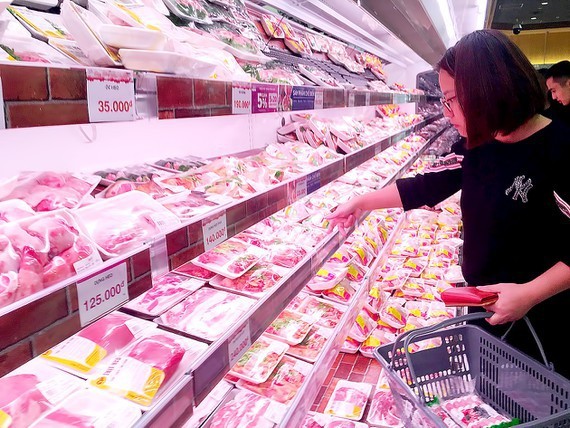November 27, 2025 | 14:22 GMT +7
November 27, 2025 | 14:22 GMT +7
Hotline: 0913.378.918
November 27, 2025 | 14:22 GMT +7
Hotline: 0913.378.918

Pork imports increased rapidly in the first months of 2021. Photo: TL.
According to the General Department of Vietnam Customs, in the first quarter of 2021, Vietnam imported 34.65 thousand tons of pork (HS code 0203), worth US$ 80.07 million, increased by 101.4% in volume and 102. 3% in value compared to the same period in 2020.
Russia, Canada, Brazil, Poland, and Denmark are the 5 largest markets supplying pork to Vietnam. In which, Russia is the largest market supplying pork to Vietnam in the first quarter of 2021 with 16.55 thousand tons, worth US$ 44.85 million, increased by 1,116.5% in volume and up 1,002.1% in value compared to the same period in 2020.
The amount of pork imported from Vietnam has skyrocketed, the domestic supply is gradually recovering after being affected by African swine fever.
In addition, consumer demand is still low, causing live hog and domestic pork prices to tend to decrease continuously.
In detail, in the first quarter of 2021, domestic hog prices decreased after increasing in January 2021. The downtrend continued in April 2021. Currently, the average price of live hogs across the country ranges from VND 70,000-73,000 per kg, down VND 2,000-4,000 per kg compared to the end of March 2021.
African swine fever is well controlled. Pig herds on large farms increased rapidly. The supply of chicken, beef, fish, shrimp, and imported meat is abundant. These are the factors that make the price of live pigs forecast less fluctuate much in the near future.

Customers buy pork at a supermarket in Ha Noi. Photo: Vietnamnet.
According to analysts, pork is still the most commonly consumed meat worldwide. An estimated one-third of all meat consumed in the world today is pork, followed by beef and chicken.
However, since the outbreak of African swine fever from 2018 to now, the total world pig herd has dropped sharply, leading to a shortage of pork supply and pushing up the price of this commodity.
Since the beginning of 2020, Vietnam has opened its doors to pork imports from Russia with an import tax rate of 0%.
The pigs in the Russian market are raised in a clean, strict hygienic environment, with a cool space. All foods are organic foods, according to the standards of the Ministry of Health. From food to environment, all must meet livestock standards.
In addition, pigs are regularly checked for health, fully vaccinated against diseases, so pigs here have few diseases and are always healthy. Those that do not meet the selection criteria when exporting will be immediately discarded.
According to data from the General Department of Vietnam Customs, the total volume of pork imported from Russia in the first quarter of 2021 was 16.55 thousand tons, worth U$ 44.85 million, increased by 1,116.5% in volume and by 1,002.1% in value compared to the same period in 2020.
In the opposite direction, data from the General Department of Vietnam Customs shows that in the first quarter of 2021, Vietnam exported 4.51 thousand tons of meat and meat products, worth US$ 17.04 million.
Meat and meat products are exported mainly to the markets of Hong Kong, Korea, and China. In which, exports to the Hong Kong market accounted for 71.53% of the total meat volume.
According to estimates by the United States Department of Agriculture (USDA), global pork consumption in 2021 is estimated to increase by nearly 5% compared to 2020 to nearly 101 million tons, lower than the 6% growth forecast in January 2021.
Excluding the United States is forecast to reduce consumption this year to 9.99 million tons, down 0.4% compared to 2020; other major pork consuming markets such as the EU, China, Russia, Brazil, Vietnam, Philippines, and Mexico all increased by 0.2% - 8.9%.
In the Vietnamese market, pork production in 2021 is forecast to increase by nearly 5% compared to 2020, to 2.59 million tons, according to USDA. Meanwhile, pork consumption will increase by 3.6% compared to 2020, to more than 2.78 million tons.
Translated by Ha Phuc

(VAN) China’s cooking oil is suddenly flooding into India. It all comes down to a soybean surplus that Beijing doesn’t quite know what to do with.

(VAN) An Giang promotes supply-demand connections, standardizes quality and builds value chains, creating a foundation for sustainable bird’s nest development and aiming to expand exports.
/2025/11/24/5339-4-nongnghiep-075331.jpg)
(VAN) Recently, the conference on 'Sustainable Fisheries Linkage Chain - Tilapia for Export' took place in Tien Hai commune, Hung Yen province.
/2025/11/21/4309-2-153400_128.jpg)
(VAN) Green and low-emission rice is paving the way for Vietnamese rice to enter high-end markets, marking the beginning of a transformation journey toward greening and elevating the national rice brand.

(VAN) ‘Right to Win’ outlines a national action plan that shapes a new vision for Viet Nam’s agriculture in an era of renewal and global integration.

(VAN) Lam Dong’s farmed sturgeon output this year is expected to reach 2,300 tons, worth VND 450 billion, affirming the brand’s position on the market.

(VAN) A surge in Ukrainian egg exports, largely driven by soaring sales to the UK over the last few years, has notably pushed up egg prices on the domestic market.